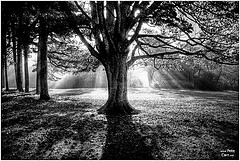Black & White photography is obsolete. It is antiquated and exists for no real reason at all, except for our desire to see the world as we can’t see it. In Black & White.
Shouldn’t we just abandon it as a technology that is no longer needed? Perhaps not. Black and White is more than just the way that images are created. It’s also how we look at those images, and what they make us feel.
Is Everything About Money?
Of course, history has its reasons why Black & White photography had to come first. Even when Colour Photography was first invented, there was a good reason why photographs were still taken with Black & White film… It was cheaper.
But it’s not the same today… Today there’s no cost involved in choosing between Black & White, and color photography. So why then, in this day and age, when our photographs are taken in 36 or 48-bit color, almost by default, why do we still have a desire to see the world in simple Black & White?
The Simplicity of Monochrome
With all the color stripped away, a black and white image could have been taken at any time. It reduces the world to the simplicity of light, vs no light (or less light), and shape. How could anything be simpler than that?
Yet, creating a masterfully composed, and exposed, black and white image on film is an art that people take years to master. They choose their tools and hone their skill, the zone system, pushing film, pulling prints, using different contrast papers and developers… These are all skills associated with developing and printing black and white film images. There’s a reason why this has a charm of its own, and there’s a reason why photographers are still so passionate about it today.
This brings us to the added complexity of digital vs film photography.
What is True Monochrome?

Does an image that is photographed with an RGB camera sensor count as black and white if it is simply desaturated? That’s not what film does – at least, not all the time.
Black and White film comes in different types. Panchromatic, and Orthochromatic. While Panchromatic film is sensitive to all frequencies of the visible light spectrum, Orthochromatic film is not sensitive to red light. This means that red objects are represented as being darker.
So, black and white representation in film is not the same as just desaturating a digital image. This is why Lightroom applies a special ‘formula’ when you decide to turn your images into ‘monochrome’. That’s why Leica brought out a digital camera that only shoots in Black and White… The Leica M Monochrom.
It’s why people love black and white images. The world becomes simpler, the frame is reduced to just shapes, and light… The color will never fade.
The Timelessness of Black & White Photos
Could it be that Black and White Photography is Timeless? Maybe it reminds us of a time gone by, in which everything was perfect? or is it just our desire to see things as they are not… as they never will be?
Do you have an answer? or something more than an answer?
Yes? Please, do share it with us in the comments below.
PS: If you have never owned a black and white print made with an enlarger, you should explore what it is that makes them special.
Help Us To Continue Creating
Get our email newsletter to stay up-to-date with our latest posts. It’s easy to read and is mailed once in 2 weeks.
The easiest way to support Beyond Photo Tips is by using our affiliate links when you buy anything at all. It will never cost you anything extra, and we get a small commission from it, which helps us a LOT! We share our recommended equipment list here.
Some of the links to products on this website are affiliate links, and we only ever link out to gear that we recommend.
You could also show your appreciation by buying us a coffee. Finally, we appreciate you being a part of the community, so do say hi!




What??? No way is b/w dead… never will be. It’s like magic, especially when on film. Oh, and film isn’t dead either!
Obsolete, antequated and no reason at all?! Sorry, but this is the most stupid thing I have heard about B&W photo.
Sometime you have a wonderful photograph you want to put on your wall. But the colors of the photo and the wall clash. Simply make your photo black and white and then it does not clash with your wall.
black & white makes the subject generic, the tree is all trees, the child is all children, the window is all windows, etc… If you take a shot of a blue car it is a “blue” car, if you take it in black and white it becomes a representation of all cars not just ones that are blue. Allowing the subject to symbolize more is what b&w is about for me.
one of the most important aspects bw adds to photography is the opportunity to showcase other elements in a picture that could otherwise be distracted by colour – the lines, the interplay of shadows, and composition as well. never ever will that be outdated. bw is one feature in photography that really adds to its artistic potential/expression
I find B&W tends to give more perspective when looking at a scene or a subject, as we feel more detached from the photograph for some reason… Perhaps because our eye somewhat awakes to the absence of colour. I don’t know, just a thought… does that make any sense?
I think Black and White make the subject look more beautiful, esp girls. Dont know the reason though…
I have never found black and white landscapes interesting
Quite honestly I find B/W to be obsolete. I am more than old enough to remember the novelty of color film, and the attendant technical challenges it brought with it. These days I see B/W used in situations where I suspect it is a crutch used by the photographer… or more accurately the “post-processer”… as a way of rescuing an image that would otherwise be extremely average (or even awful) if it were in color.
Oh sure, Ansel Adams did great stuff with B/W… kind of the old school equivalent of the now brutally overdone color HDR, but that was because he didn’t have a choice. And even with the tremendous crutch/advantage of working in B/W I have not seen a “digital Ansel Adams”, which seems to add credence to my theory that a great many digital images presented in B/W started life as a mediocre color picture.
As a result of removing color, through showing imagery in shades of gray, the observer is able to give attention to two vital things: luminosity and composition. A number of subjects are basically more striking, maybe dreamy, in black and white. A high-quality black and white image has a sense of melody and anonymity, personally.
Some Interesting points here…
But first let me clarify my stand on the subject:
I’m not against B&W photography. Brian, I know you love your film and your B&W, as do many other people here… I do too… I don’t take many Monochrome images though. I just prefer colour.
No, B&W is not Dead. I doubt it will ever really die.
Obsolete – Yes, I think that B&W film photography is an obsolete technology.
Antiquated – Yes, for the same reason as above.
Exists for no reason at all – well… for no “practical” purpose… It does exist for artistic reasons and for personal preference.
I personally do not subscribe to the school that takes the ‘easy way out’ by making a colour image greyscale… yes, I’ve done it when I’ve had to rescue images, but I encourage you to try doing things the ‘right’ way… To take more care in your selection of lenses, films, ISO, and aperture. Previsualise…
Digital Ansel Adams? Well, I believe that the problem is that there are too many of them around. And that reduces the impact of any one of them alone.
Ansel Adams himself was brilliant for his time. His work on the Zone system alone is unparalleled.
I could ramble on for ages, but I’ll stop here and let you voice your thoughts.
I’m still looking for one wonderful reason why B&W photography absolutely rocks. Matt Dinkel and Capa have gotten really close to that.
It’s really interesting reading all the different views.
As with any type of photography b&w means different things to different people, and that’s why I love photography…
As with colour there are good and bad b&w photographs
But for me I like the detail that can be brought out in a good b&w shot when the colour isn’t there to catch our eyes in a photograph. The tree above is a good example of this.
Love the discussion…
Mandy,
That’s what I’m hoping to drive, here on Beyond Phototips… Discussion.
It’s been great, looking on as people express their views and opinions. One should remember that each person has a unique perspective based on his or her experience or lack thereof.
Each unique… and I love hearing them. I’ve got my own, and it’s wonderful, seeing people react to them.
Thanks for stopping by.
To add to my comment earlier…
Nevertheless, black and white, as well as color, continue to be in use to this day, regardless of the advances in technology. There is just a certain amount of nostalgia that surrounds black and white photography, that color just can not seem to bring to the forefront. Let’s face it, “there are black and white snobs, as well as [color] snobs”. Be it black and white or color, a photographer should not be judged by the technology put to use, but how it is used.
Thanks for the great discussion.
I’ve kept this post unread in my Google reader for awhile because I wanted to responded, but wasn’t sure how. I’m still not sure how.
A B&W image let’s the photographer tell a story that has more contrast and depth. It leaves the unnecessary details for the viewer to imagine and provides the crucial details.
I have a love for B&W photos that I’ve really never been able to explain. Sure, times have changed and the technology of B&W film is obsolete, but the desire to see and capture the perfect B&W image is still alive and kicking.
i have played around with black and white images in the past and still to this day continue my love for the classic feel!
while studying fashion at college i did a side course in photography and chose to go old school and use old black and white film photography to seperate my work from the rest!
it got a really good response i fell back in love with film!!!
To me, monochrome photography provides focus.
In my own photography education, our professor required us to shoot black and white film for that very reason. We weren’t distracted by other details when we were trying to learn about composition and processing. I believe that every photographer should learn using black and white before they get into the world of color.